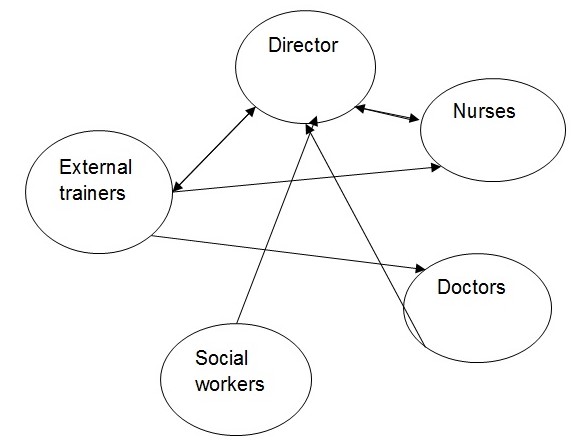Group activity
The hospital management observed that cases of pressure ulcers among the patients have increased at an alarming rate. Our group was formed with an aim of discussing ways of improving the general health care and reducing cases of pressure ulcers among the inpatients. By addressing these issues, the hospital will become organized and patients will receive quality services (Blais and Hayes, 2011).
Type of group
This type of group is referred as secondary group because of the nature of our group (Polich and Scandlyn, 2005). Unlike primary groups, our group was formed with set objectives and clear goals. In addition, our group consisted of several members unlike primary group, which has only few members.
Group participants
Our group had several members who participated actively to ensure success and attainment the goals. The group consisted of the hospital director, external trainers, doctors, nurses, and social workers. The group felt the need to involve the entire stakeholders to promote fairness and encourage participatory decision-making (Polich and Scandlyn, 2005).
Goals
The main objective of the group was to discuss ways of improving general health care and reducing pressure ulcers among the inpatients. The group activities aimed at discussing the necessary changes that would encourage and improve the quality of service delivery in the hospital. Due to increased cases of pressure ulcers, the group set out to develop new techniques that would reduce such cases in our hospital (Blais and Hayes, 2011).
Member commitment and cohesiveness
The members of the group used self-disclosure, which is high levels of commitment and cohesiveness (Levi, 2010). There was a high level of participation in the group. During brainstorming stage, a third of the members gave ideas on how the nurses can help in improving general health care. The participants assigned themselves different roles in the group. After the group discussion, everyone helped in cleaning the room before leaving.
Leadership style and role
The hospital director was in charge of the group by making sure the discussion was conducted in a proper manner. The leadership style used is participative or democratic leadership and this is evident in the way the director created a friendly environment, which encouraged open discussion (Levi, 2010).
Type of decision
To ensure quality decision, all the participants were involved in making the decision but the hospital director gave the final word. In deed, the members of the group were very cooperative and a decision was arrived using the objective method (Burtis and Turman, 2006).
Group behavior and participation
There were few cases of members making noises during the discussion. However, most of the members were able to stick to the agenda throughout the group process. One of the nurses took the role of the secretary, while one of the nurses acted as the representative of the nursing body. The hospital director was the leader in charge of the meeting and ensured that the members of staff were able to get along. There was a case where one of the nurses wanted his ideas to be considered but the director explained that it was important to give all participants an opportunity.
Interaction pattern
Multiple applications interaction technique was employed in the group discussion and all members were active. Because of the friendly environment, the interaction pattern was positive. The director, nurses, and doctors were very active because the anticipated changes affect them in one way or the other.

Power
Concerning power, the approach used in the group is referred as the circle format (Burtis and Turman, 2006). This method of power in a group allows the members to participate fully, respect others opinions and discuss issue openly. In fact, this technique of power in the group allowed the members to discuss issues openly while providing creative ideas.
Group effectiveness
The group activity was effective because the set objectives were attained. All members were active in the process of decision-making, which contributed to success. At the adjournment stage, the group had achieved all the set objectives. Generally, the group activity was effective since we formulate new ideas and some of them have already been implemented.
Improving group process
In conclusion, as a leader it is important to ensure that any group activity is successful and all agendas are addressed. To improve the group process, I would encourage active participation, set agendas in advance, stick to the set agenda, encourage open discussion, emphasize on the importance of time management, encourage good meeting behaviors, and promote commitment (Burtis and Turman, 2006).
Reference List
Blais, K., & Hayes, J. (2011). Professional nursing practice: Concepts and perceptive. (6th Ed.). New Jersey: Prentice Hall.
Burtis, J., & Turman, P. (2006). Group communication pitfalls: overcoming barriers to an effective group. California: Sage.
Levi, D. (2010). Group dynamics for teams. California: Sage.
Polich, L., & Scandlyn, C. (2005). Small group strategies: Ideas & activities for developing spiritual in your students. Miami: Zondervan.